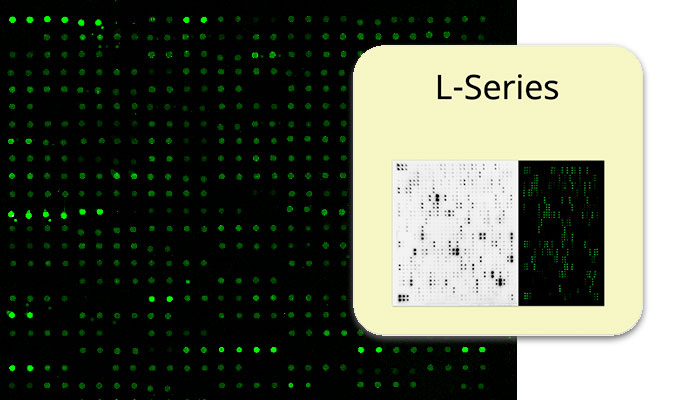In a previous post, I introduced the G-Series Mouse antibody arrays to profile up to 200 mouse proteins using a combination of 5 antibody arrays on glass slide. This new Mouse L2 L-Series (label based antibody array) goes one step further in the number of targets to profile – 500 on one single array – allowing you to work with smaller sample volume. Read more about the technology and its advantages in this post, whether you’re considering using it in your lab, or outsourcing your project to save time & ressources.
How does it work?
Let’s have a look first at the array technology and principle. Through a simple labeling process, the sample proteins are directly conjugated to biotin, eliminating the need for a second antibody to develop the array signals. In this format, unintended antibody interactions are impossible, thus eliminating limitations on the size of the array panel.
Through a simple process, the primary amine of the proteins in the sample is biotinylated, followed by dialysis to remove free biotin. From here, the newly biotinylated sample is added onto the array membrane or glass slide and incubated at room temperature. After incubation with HRP-streptavidin (Membrane format) or Fluorescent Dye-Strepavidin (Glass slide format), the signals can be visualized either by chemiluminescence or fluorescence. The experimental procedure is simple and can be performed in any laboratory. The image below is a short summary of these steps.

RayBio® L-Series Antibody Array Membranes or Glass Slides
The picture below displays the 4 subarray layout on the glass slide, just for you to figure out more pratically how it works…

…together with the incubation chamber used for easy processing of each incubation step…

What are the real benefits of the array?
As I mentioned in my introduction, you can work with small sample volumes even when looking at such a high number of mouse targets (500); indeed as little as 20ul to 30ul of serum or plasma for the glass slide format are sufficient. This is a real advantage for mouse samples where volume is often limited. It is easy to use and you can get results in less than 2 days with no need for complex sample preparation. However, if you’re reluctant to spend too much effort on a one shot experiment, and are likely to want to boost your project to the next step in a few weeks, you can also outsource it to a European lab (no custom clearance complications with your sample shipment, if you’re in the EU). The data will be sent out to you by your designated project manager in the form of an Excel sheet, normalized after background substraction. Biostatistics services are available to help you get the most of your data, at very reasonable cost.
Just to summarize the array benefits in a few points:
- High detection sensitivity
- Easy to use; obtain results in 2 days
- No need for fractionation, depletion or extraction of samples
- Consumes only 20-30 ul of serum/plasma
- No dedicated equipment needed (glass slide or membrane)
- Easily outsourcable to a European lab
In which applications can you use it?
Obviously this is for High throughput expression profiling where you will compare mouse samples with one another and get results in the form of ratio and up or down-regulation of protein expression; whether you wish to discover potential molecular targets for drug development, uncover mechanism of drug action, discover expression patterns for molecular action, while working on a mouse model. You may also wish to confirm that what you observe in a human model is reproducible on the mouse model you will be using for some other tests.
Want to have a look at the target list?
You can access the full target list on pages 19-20 of the protocole of the Mouse L2 array. Alternatively, the selection of targets from a slightly smaller Mouse L-series array (308 targets) may be suitable for you. Just check it in the Mouse L308 protocole on page 19.
In any case, feel free to contact me if you have any questions, as we have other solutions available for broad or focused protein profiling in mouse samples. I’ll be happy to help!


